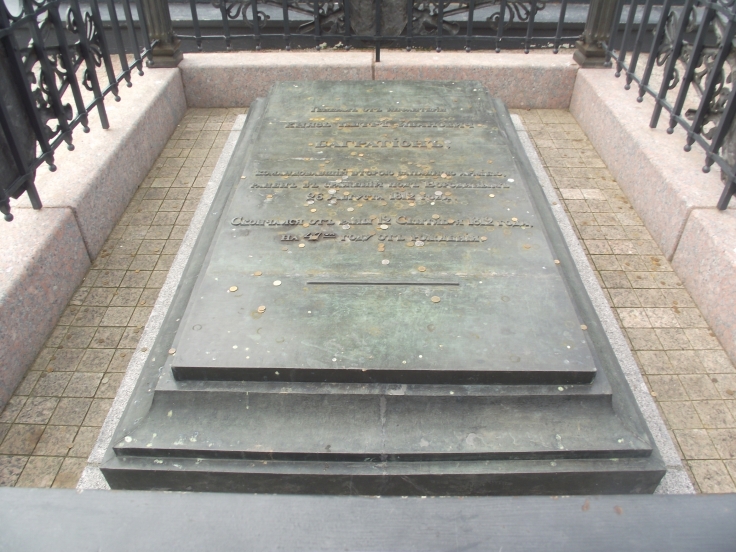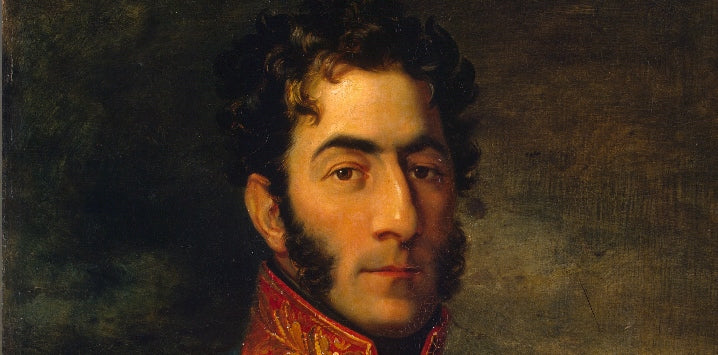The Battle of Borodino, fought on 7 September 1812, is one of the most famous in the Napoleonic Wars as well as the whole of Russian history. Over the course of the two centuries since the battle, the Russian authorities have staged ceremonies commemorating the significance of the struggle between Napoleon and the Russian Army in 1812. One of the earliest and most important of these was in 1839, when Tsar Nicholas I presided over the unveiling of the main battlefield monument on the Great Redoubt, at the foot of which Prince Pyotr Bagration’s remains were transferred from his original grave at Sima in Vladimir Province.
The following account, translated from Russian, describes the military and religious ceremonies held over three days in Sima, when Bagration’s body was exhumed before being brought to Borodino. The author of the account is Prince Nikolai Borisovich Golitsyn (1794-1866), a Russian aristocrat perhaps best known as an amateur musician and the patron of three of Beethoven’s late string quartets. In his youth he had served in the Russian Army in 1812-14 during the Napoleonic Wars and was an ordinary to Bagration at Borodino. The Golitsyns were distant relatives of Bagration, who after his wound was brought to the Golitsyn estate of Sima, where he died on 24 (12) September 1812.

Prince Nikolai Borisovich Golitsyn
NB: The dates below are given in the Old Style Julian Calendar, 12 days behind the New Style Gregorian Calendar.
The Transfer of Prince Bagration’s Body to Borodino Field
A touching and grand ceremony took place in recent days in the village of Sima in the Yurievsky District of Vladimir Province. Perhaps not everyone knows that General-of-Infantry Prince Bagration, after being wounded at the Battle of Borodino, was given use of the estate of his friend, Prince B[oris] A[ndreyevich] Golitsyn – the aforementioned village of Sima, where, on 12 September 1812, he died, and was buried inside the local parish church.

Prince Bagration's original grave, Sima, Vladimir Province
His Imperial Sovereign was pleased to order the mortal remains of the famous heroic commander to be transferred to the place where he received his mortal wound while defending the fatherland. In accordance with the Imperial will, the Holy Synod asked His Grace Parfeniy, Archbishop of Vladimir and Suzdal, to hold a religious ceremony. The former adjutant of the late Prince Bagration, the famous partisan D[enis] V[asilyevich] Davydov, was entrusted to accompany the body to all the way to Borodino, with an honour guard of the entire Kiev Hussar Regiment, which was quartered in Yurievsky District. But his untimely death prevented him from fulfilling this sacred duty, and, according to orders of the government, the entire military ceremonial was entrusted to the commander of the Kiev Hussar Regiment, Colonel Kenskiy.
The exhumation, the solemn commemoration, and the transfer of the body to the Borodino Field, was scheduled for 3rd, 4th, and 5th of this July. Being one of those who had the honour of being in attendance to Prince Bagration during the bloody Battle of Borodino, and then to accompany him wounded to Moscow, I considered it my sacred duty to be present at this touching ceremony, which both in its aim and in the memories it stirred up, must resonate deeply in the soul of every soldier, especially a soldier of that era.
The honour His Imperial Majesty deigned to bestow on the remains of a commander unprecedented in the glory of the Russian Army after twenty seven years, by ordering them to be transferred to Borodino Field at the same time as the solemn unveiling of a monument to the glory of the fallen on this bloodstained soil, shows how highly the Tsar values his military duties. O! How comforting is such attention to each son of the fatherland, and how powerful it will serve as an encouragement to imitate the glories of these men!
And so on 3rd July, we were to behold the grave which contained the honoured remains of the hero of Borodino. On the morning of that day the entire Kiev Hussar Regiment gathered in the village of Sima. On the same day the Archbishop arrived with his honoured clerics. At 6 o’clock in the evening, they began to raise from the grave the coffin which had been lying within it for more than a quarter of a century, which appeared completely intact. Without being opened, the coffin was placed straight from the grave into a lead coffin made for the occasion, which would be placed into the new magnificent sarcophagus.
Then the memorial service began, led by Archbishop Parfeniy with his assembled clergy. The gathering of the common folk, who had been brought together from all sides over several days, was incredibly large.
On the morning of the 4th, the provincial governor arrived, and with him a rather significant number of nobles, some of whom even came from faraway places. At nine o’clock the Archbishop began to perform the Liturgy, and the service for the repose, and before the end made a speech in honour of the memory of the hero’s greatest deeds. On the same day, a vast hall in the form of a tent was raised in the garden next to the house of the present owner of Sima. It covered a dining table with 100 places, to which were invited the Archbishop and his honoured clergy, the Civil Governor, the entire officer corps of the Kiev Hussar Regiment, and all the other nobles who had travelled for the solemn ceremony.
Meanwhile, during this whole time, crowds of commoners did not cease to surround the coffin, placed inside the church, and the clergy had difficulty satisfying the zeal of those who had arrived to pay their respects to the departure of the late commander.
On the 5th, at 8 o’clock in the morning, after the Liturgy, the Archbishop completed the memorial service. After this the senior officers of the Kiev Hussar Regiment, alongside other distinguished retired soldiers, raised the sarcophagus, carried from the church and placed it in a richly decorated carriage with a canopy, which was to bring the treasured remains to Borodino. The sarcophagus was accompanied by an icon of the Holy Mother of God of Smolensk, which Prince Bagration had with him at all times on his campaigns, and from the time of his death was kept in the Sima church over his grave.
The people asked for permission to pull the carriage: it was impossible to deny such burning zeal. The procession began in the usual order. The clergy at the front, behind it the funeral carriage, and the Kiev Hussar Regiment at the rear. The trumpets played a funeral march. Spectators were scattered across a boundless space. Before leaving the village, the Archbishop performed the funeral prayer for the final time and blessed the journey. The carriage was harnessed to horses, and the sad procession continued quietly. In spite of the scorching sun, most of the folk accompanied the carriage the whole way to Yuriev, a distance of 20 versts [approximately 21km]. Thus the village of Sima relinquished its prized asset, but the Borodino field awaited the honour due to it in the form of the glorious remains of the hero.
When Prince Pyotr Ivanovich Bagration died at the village of Sima, in complete solitude (The master of the Sima estate, Lieutenant-General Prince B. A. Golitsyn then commanded the entire Vladimir militia, and his many family members owing to the circumstances then were dispersed in the borders of the fatherland), there was no-one to shed tears for him, no-one to administer the parting rites at the grave.
Now, the occasion of this mournful ceremony, with revived funeral rites, at which none of his friends and companions were able to be present, will allow us to recall one last episode of his military life, which demonstrates that in this man the virtues of a great commander were further adorned with the qualities of a gallant gentleman.
Everyone knows with what bravery and what masterful manoeuvring in 1812, Prince Bagration overcame all the difficulties and obstacles before him on the road to join up with the First Western Army. But at the time when he employed all his mental faculties and all the qualities of a prudent commander in order to achieve this important goal, he knew that upon the junction of both armies, he had to subordinate himself to the command of his junior General Barclay de Tolly.
But was this the place for his noble soul to feel his pride offended? When Barclay arrived in Smolensk, then Prince Bagration approached him, and said: “I present myself to you as towards my chief: now is not the time for considerations of seniority in rank, Russia is in danger, the Tsar orders us only to think about the salvation of the Fatherland, and to direct all our efforts to this end.”
How sorrowful would the last minutes of life have been for a heart which burned with such love for the Fatherland at that moment in time. At Borodino Prince Bagration fought like a lion. He courageously held a weak position on the left wing against a considerably larger enemy force, and offered himself as a sacrifice!
But he was only able to witness the grief to his motherland. The retreat after Borodino, the enemy’s capture of Moscow, the fire of Moscow, the desecration of holy sites, all these supernatural circumstances, which carried in themselves the seed of great power and magnificent triumphs for Russia, could have only seemed to him, as he suffered in his soul and body, as the humiliation… the destruction of the Fatherland!…

The Grave of Prince Bagration, Borodino
But be comforted, valiant soul! Russia will never forget your service: [Tsar] Nicholas, after twenty seven years, wants to honour your remains in a tomb worthy of your glory, and upon the place where you demonstrated how a Russian should die for Rus, and your memory will never be extinguished in the hearts of the true sons of the Fatherland! Not on this earth did you taste the reward of your heroic selflessness.
- Prince Nikolai Golitsyn
Sima, 10 July 1839



Share and get 15% off!
Simply share this product on one of the following social networks and you will unlock 15% off!